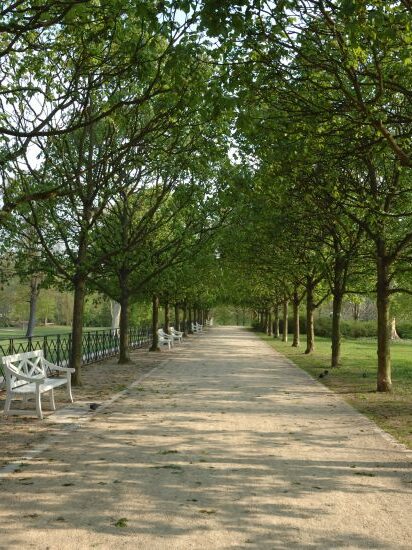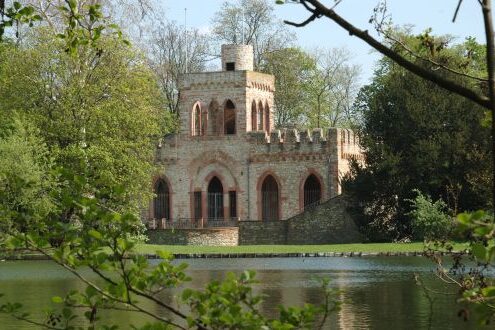Biebrich Palace Park
Biebrich Palace Park is one of the largest and most beautiful parks in Wiesbaden. It was first laid out at the beginning of the 18th century, initially as a small ornamental garden.
The history of Biebrich Palace Park is inextricably linked to the history of Biebrich Palace. Like its architectural history, the development of the park took place in several stages. In the first decade of the 18th century, a small Baroque ornamental garden was created to the north of the two pavilions, which were connected by a balustrade. Around two and a half acres in size, it essentially consisted of geometrically shaped flowerbeds surrounded by clipped box hedges.
Under Maximilian von Welsch, this garden was extended to around 28 acres (approx. 7 ha) between 1709 and 1719/20. The entire terrain was lowered and the resulting parterre was designed as a pleasure garden in the French style. Surrounded on all sides by a terrace, it extended as far as an orangery planned in a semicircle to the north. A large fountain built in 1708 formed the height and center of the garden. Directly behind the orangery and on the grounds to the west of the pleasure garden, the "lower garden" extended in the form of so-called bosquets, which, in keeping with Baroque taste, contained a maze and a hedge theater. To the north of the Boskette behind the orangery was the "Dicke Allee", an avenue of chestnut trees, which had been laid out in 1712 along the central axis of the palace starting from the rotunda. Around 900 meters long and located outside the garden grounds, it connected the palace with the medieval moated castle in the neighbouring village of Mosbach. In addition, a kitchen garden and orchard were laid out on the grounds to the west of the garden parterre and a greenhouse and garden to the east of the northern Boskette.
Under Friedrich Joachim Stengel, appointed Maximilian von Welsch's successor in 1733, the garden was redesigned and extended. In 1740, Stengel had the eastern wing of the orangery, which had already been completed, removed and smaller chestnut avenues laid out in the extension of the newly built palace wings. The main axis led from the palace to a traffic circle with a large fountain and ran northwards in a star shape. The "Dicke Allee" still formed the continuation of the main axis outside the garden. The extended and redesigned pleasure garden was now surrounded to the west and north by a water channel fed by the Mosbach and navigable by boat.
After the Baroque gardens were devastated by French revolutionary troops during the reign of Karl Wilhelm, Prince of Nassau-Usingen (1775-1803), his brother Prince Friedrich August, Duke of Nassau-Usingen since 1806, had the gardens restored during his reign (1803-1816). The garden grounds were extended to over 200 acres (approx. 50 hectares) through land purchases. Court architect Carl Florian Goetz now laid out contemporary meandering paths on the terrain of the Baroque pleasure garden. From 1805/06 to 1816, he elaborately converted the old castle into a medieval-looking romantic residential castle, the Mosburg, where Friedrich August was particularly fond of living.
The park finally underwent radical changes under Duke Wilhelm von Nassau-Weilburg (1816-1839). He commissioned Friedrich Ludwig von Sckell to redesign the entire area between the palace and Mosburg. According to his plans, an extensive English landscape garden was created between 1817 and 1823. The picturesque and newly created central motif was, and still is today, the visual aisle leading from the rotunda to the north, west of the Baroque central axis. This meadow valley is framed by meandering tree-lined paths. "Dicke Allee", Mosburg and the newly excavated Mosburg pond were cleverly integrated. The project was completed in 1826 with the construction of the northern gate and the warden's house by Friedrich Ludwig Schrumpf.
In 1839, Duke Adolf von Nassau succeeded his father Wilhelm. He used the palace as a residence for the summer months and devoted all his attention to the park. Between 1845 and 1848, he had the architect Robert Jahn build a large greenhouse complex with a palm house and conservatory on the eastern edge of the park. The five-aisled group of show houses, a modern glass and iron construction, was considerably extended twice more, in 1854 and 1861. The south-western section of the park was also redesigned. Von Sckell had already created a small lake here. The redesign of the area north of the rotunda between the two wings was based on an idea by architect Richard Goerz. In 1851, the two fountain basins were created according to a design by the Berlin sculptor Emil Alexander Hopfgarten and installed in place of von Welsch's old fountain basins. The large fountain, reconstructed in 1995, has been preserved.
The Duke's preference was for exotic trees and plants as well as rare flowers. Under garden director Carl Friedrich Thelemann, around 190 different tree varieties were planted, of which around 90 still exist today. The palace park experienced its last heyday during the reign of Duke Adolf. The three magnificent flower and plant exhibitions in the architecturally decorative Ducal Nassau Winter Gardens, which were also open to the public, were a great success.
After the annexation of the Duchy of Nassau by Prussia, Adolf sold his famous Biebrich greenhouses with over 20,000 different plants to the newly founded Palmengartengesellschaft in Frankfurt am Main in 1868, which laid the foundations for the Palmengarten with this acquisition. The park remained in Adolf's possession and became overgrown. Sold to the Prussian state in 1934, the palace park is now owned by the state of Hesse. It is managed and maintained by the Hesse State Office for Construction and Real Estate. Since the 1950s, the International Whitsun Tournament of the Wiesbadener Reit- & Fahrclub e.V. has been held in the park every year.
The Mosburg, built as a "mock ruin", situated on a peninsula in the later created Mosburg pond (1818-1823) and originally provided with its own castle garden, was used in a variety of ways until the end of the Second World War. Duke Friedrich August had it magnificently furnished with original medieval art objects and great attention to detail. For example, he had tombstones of the Counts of Katzenelnbogen from the dissolved Cistercian monastery of Eberbach installed as gatekeepers. Primarily the duke's private retreat, it also provided a glamorous setting for social receptions and princely celebrations.
Under Duke Adolf, the Mosburg served as a studio for the important Berlin sculptor Emil Alexander Hopfgarten from around 1849 to 1856. Among other things, he created the sarcophagus of Duchess Elisabeth Mikhailovna for the Russian Chapel as well as figures for St. Boniface's Church and the Christ and Evangelist group for the Market Church. After Hopfgarten's early death, his works and models could still be viewed in the Mosburg Hall until 1874.
During walks with Duke Adolf in the castle park in 1862, Richard Wagner discovered the idyllic mock ruins as a possible place to live and work. However, Adolf did not give in to his wish to move in.
From 1909, the large hall of the Mosburg housed the newly founded Biebrich Museum of Local History (Heimatmuseen), which was plundered during the Second World War and eventually dissolved. The castle itself fell into disrepair in a very short time as penetrating moisture destroyed the wooden structures of the flat sloping roofs. Like the castle park, the ruins of Mosburg Castle are owned by the state of Hesse and are currently being renovated by the Hesse State Office for Construction and Real Estate in several construction phases according to monument conservation criteria.
Literature
The palace and Biebrich Palace Park are managed by Landesbetrieb Bau und Immobilien Hessen.
- Geurts, Sonja
Biebrich Palace and Palace Park. Landscape park designed by Friedrich Ludwig von Sckell with castle and Mosburg, Regensburg 2000.
- Handke, Manfred; Modrow, Bernd und Nath-Esser, Martina
Park maintenance plan for Biebrich Palace Park in Wiesbaden. Principles for the care, restoration and long-term preservation of the historic park as a cultural monument, Bad Homburg v.d. H. 1987.


